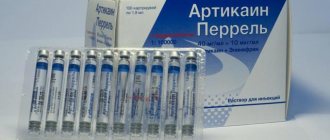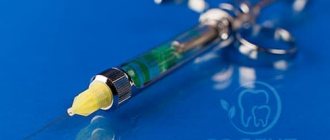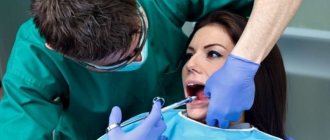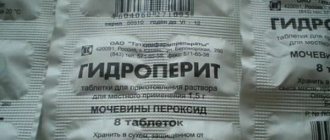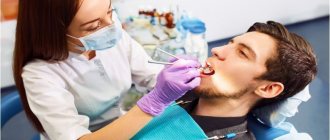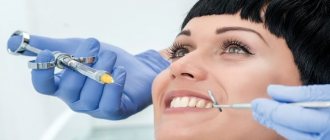What kind of drug is this - general information
We are talking about a high-quality anesthetic solution, which has been used in dental practice for quite some time. Manufactured by the French company Septodont. Until recently, the drug had exclusively analgesic properties and was produced without adrenaline, but later epinephrine (synthetic adrenaline) was added to its composition, a component of vasoconstrictor action. This made it possible to prolong the anesthetic effect and increase its reliability.
Thus, the composition includes two main active ingredients - articaine and epinephrine. The product is used for medical procedures of varying degrees of complexity, including simple surgical interventions and patch surgeries.
Release form and composition
The solution is available in 1.7 ml injection cartridges - they look similar to standard syringes, only the needles in them are many times thinner. This feature allows the injection to be performed with minimal discomfort for the patient. The drug is presented in two concentrations of the active substance: 1:100,000 and 1:200,000. The price, which varies from 1,500 to 2,000 rubles, also depends on this indicator.
The drug contains articaine and epinephrine
As mentioned above, Septanest contains articaine and epinephrine, as well as auxiliary components such as sodium hydrochloride, sodium bicarbonate and water. For comparison: articaine is 2 times more effective than lidocaine, and novocaine is 6 times more effective1.
Thanks to this composition, Septanest not only blocks pain receptors and neuromuscular transmission, but also affects blood supply. Epinephrine reduces the rate of penetration of articaine into the vascular bed, thereby providing a longer lasting analgesic effect. In this case, the drug is quickly excreted by the kidneys.
Anesthesia in dentistry
The best drugs for local anesthesia in dentistry
As we said, most often in dental clinics drugs based on articaine are used, in particular Ultracaine or Ubistezin. Now, taking into account the information presented, it is time to dwell in more detail on the advantages of such anesthetics.
Artikain
Modern local anesthesia in dentistry is unthinkable without articaine. It is this anesthetic that has a minimal ratio of toxicity and analgesic activity. In other words, among the most effective remedies, it is the least toxic.
Articaine is actively used for infiltration and conduction anesthesia. It is also used for intraosseous anesthesia before dental operations. But the surface anesthetic effect of articaine is not typical, which is why it is not suitable for applications.
The advantage of articaine is its high effectiveness against inflammation. (The inflammatory process reduces the effect of many drugs). This feature allows the use of Ultracain or Ubistezin in the treatment of purulent-inflammatory diseases of teeth and periodontium.
Due to its low toxicity, articaine is the best remedy for pediatric dentistry, the elderly, and patients with diseases of the hepatobiliary and urinary systems. Can be used while breastfeeding. Articaine practically does not penetrate into breast milk, and if it is found in it, it is in extremely low concentrations that have no clinical significance.
Can articaine be used during pregnancy? Studies have shown that although articaine crosses the placental barrier, it does not have a toxic or mutagenic effect on the fetus. Articaine can be used during pregnancy.
Lack of articaine in the average duration of action. It is quickly absorbed into the blood, quickly destroyed and excreted in the urine. This is partly due to the fact that articaine, like many local anesthetics, dilates blood vessels. For this reason, articaine is often used together with vasoconstrictors, which are already included in the drug. For example:
- Ultracain DS Forte, Ubistezin Forte contain adrenaline in a concentration of 1:100,000 (average concentration).
- Ultracain DS, Ubistezin contain adrenaline in a concentration of 1:200,000 (low concentration).
What if the patient belongs to a risk group and cannot be injected with an anesthetic with adrenaline? In this case, you need to use Ultracaine D - a drug with articaine without a vasoconstrictor component.
During pregnancy, it is recommended to use articaine in combination with adrenaline in low concentrations (Ubistezin, Ultracaine DS). Some experts believe that it is better not to use vasoconstrictors at all when treating pregnant women. Which option is better? The choice must be made taking into account individual characteristics. A woman should consult with specialists, including a gynecologist who monitors the pregnancy.
Lidocaine
Lidocaine is another popular and widely used drug, despite the fact that it is 2 times more toxic than procaine. The advantage of lidocaine is its average duration of action and more pronounced effect (it is 4 times stronger than procaine). The problem is that lidocaine dilates blood vessels, which requires the simultaneous use of high doses of a vasoconstrictor drug. For this reason, lidocaine is rarely used for conduction or infiltration, but is often used for superficial anesthesia.
Can lidocaine be used during pregnancy? We have already mentioned one drawback - the drug requires the use of adrenaline in high concentrations. The second disadvantage of lidocaine is that it is toxic, crosses the placenta and accumulates in the fetal liver. Considering the above, local anesthesia with lidocaine is contraindicated for pregnant women.
Mepivacaine
A unique drug, because it is the only anesthetic for local anesthesia with a vasoconstrictor effect. This feature allows the use of mepivacaine without a vasoconstrictor, which makes it the best tool for providing anesthetic benefits to patients at risk (diabetes, thyroid disease, hypertension and other cardiovascular diseases).
Mepivacaine is actively used for infiltration and conduction anesthesia. It is contraindicated during pregnancy because it penetrates the placental barrier and narrows the uterine arteries, which can lead to fetal hypoxia.
Anesthesia in pediatric dentistry
The problem of anesthesia in pediatric dentistry is quite acute, since it is psychologically and physically difficult for young patients to withstand a long treatment procedure. On the one hand, they are frightened by the noise of dental instruments, on the other hand, it is simply difficult for them to sit still for 40-60 minutes. In this regard, instead of local anesthesia, the dentist may recommend anesthesia.
Anesthesia in pediatric dentistry is carried out using a modern drug - Sevoran. Unlike the previously popular ZAX (nitrous oxide-oxygen mixture), Sevoran combines not only high efficiency (sufficient depth and duration of medicated sleep), but also maximum safety and a very “clean” recovery from anesthesia. After waking up, the child feels great; headaches, nausea or dizziness are extremely rare.
You can learn more about the methods of providing anesthesia in pediatric and adult dentistry at a consultation with a medical dentist.
Make an appointment
Indications for use
"Septanest" is used in dentistry for infiltration and conduction anesthesia during standard medical procedures and operations of varying complexity. Among the main indications for its use, experts highlight the following intervention options:
- removal of 1-2 or more teeth,
- treatment of caries and pulpitis (inflammation of the neurovascular bundle inside the tooth),
- depulpation – partial or complete removal of a nerve,
- bone surgeries, including removal of affected areas due to osteomyelitis,
- implantation,
- endodontic treatment – treatment and filling of root canals,
- operations on the mucous membrane, etc.
The solution is used for tooth extraction
“My doctor told me that Septanest is one of the best anesthetics, and I completely trust her. She explained that there is almost no bleeding with it, so it is very comfortable to work with. And of course the effect is stronger than other drugs. Personally, I never had any side effects, any procedure was painless. And they removed the nerve and treated the canals. I was terribly worried at first, but then after several procedures I completely calmed down. Now I’m not afraid to treat my teeth at all.”
Valeria Gapak, from correspondence on the forum www.32top.ru
The drug is widely used both in therapeutic treatment and in prosthetics and implantation. It has established itself as a high-quality, effective and proven product that guarantees complete painlessness and maximum comfort during the procedure.
Evaluation of the effectiveness of the use of articaine anesthetics “Brilocaine” and “Septanest”
Most therapeutic interventions in the maxillofacial area are accompanied by pain of varying degrees of intensity, so high-quality pain relief during their implementation is an urgent problem in dentistry. Improving dental care for the population is impossible without the introduction of effective modern anesthetics into everyday practice. Today, the interchangeability of drugs is one of the most serious controversial issues both in Russia and throughout the world. According to experts, the production of generics is the most important and leading strategic direction for the development of the pharmaceutical industry, which will continue in the next decade.
An original drug is a new drug, synthesized for the first time and undergone a full cycle of research, the active ingredients of which are protected by a patent for a certain period, and significant intellectual and material resources have been spent on development, clinical trials, production and introduction to the market. Generic is a reproduced medicinal product, similar to the patented (original) one and introduced to the market after the patent protection period of the original has expired.
The algorithm for the production process of generic and original pharmaceuticals is the same and meets WHO requirements, which regulate strict standards in terms of premises, equipment, raw materials, personnel, quality control methods, etc. However, the procedure for registering generics is much cheaper and takes less time, since it does not require a full cycle of clinical trials.
Currently, there are a sufficient number of original drugs and generics of the articaine series on the domestic dental market. Brilocaine is a combination drug for local anesthesia in dentistry.
Indications for use: infiltration and conduction anesthesia, including in patients with concomitant somatic pathology.
Contraindications for use:
- hypersensitivity to articaine, adrenaline, sulfites, auxiliary components of the drug;
- bronchial asthma with hypersensitivity to sulfites;
- porphyria, hyperthyroidism, angle-closure glaucoma, paroxysmal tachycardia, atrial fibrillation, simultaneous use of non-selective b-blockers.
Purpose of the study
To evaluate the effectiveness of using the anesthetic "Brilocaine" at a dental appointment.
Materials and methods
In January-March 2015, 22 dentists were surveyed. All of them are employees of municipal dental clinics in Volgograd. To assess the effectiveness of pain relief, subjective and objective indicators characterizing the intensity of pain in the patient were studied. For this purpose, visual analogue scales were used, which are widely used in clinical consultations. Each time after using the anesthetic Brilocaine, dentists assessed the quality of work with it.
Results and its discussion
The majority of procedures performed using the anesthetic Brilocaine were dental treatment – 55.2%. Dentists also used the drug for extraction of teeth under infiltration and conduction anesthesia (22.6% and 9.5%, respectively), preparation of teeth for artificial crowns under infiltration anesthesia (13.5%), performing operations on the soft tissues of the maxillofacial area and interventions on the oral mucosa. At the same time, 84.4% of respondents rated the analgesic activity of the anesthetic as high (the onset of anesthesia from the moment of administration is 1–3 minutes, high-quality anesthesia throughout the entire intervention), 9.3% of respondents considered the activity of Brilocaine to be average (slower achievement of the anesthetic effect by compared with other articaine anesthetics). And only in every 16th case of using Brilocaine, anesthesia came on slowly, the first injection was not enough (6.2%).
The majority of doctors (87.5%) calmly performed the manipulation; in 6.2% of cases, the patient experienced slight pain during treatment, but no additional administration of the drug was required. Also, 6.2% of dentists reported that the patient experienced pain during treatment and required additional administration of the drug (Fig. 1). Assessing what exactly could have influenced the weak anesthetic activity of Brilocaine, respondents noted the neglect of the inflammatory process, accompanied by a deterioration in the general condition of the body and the individual characteristics of the emotional sphere of patients who were anxious before starting treatment.
Fig. 1. The effectiveness of manipulation using the anesthetic “Brilocaine”
Most dentists, when choosing medications, preferred original drugs (82.4%), 12.5% did not see the difference, and only 5.1% of respondents chose generics, which indicates doctors’ distrust of domestically produced drugs.
Of the adverse reactions accompanying the administration of the anesthetic Brilocaine, 2.7% of respondents noted an increase in heart rate (Fig. 2), which is comparable with the data of I.V. Fomichev, obtained during a study of the drug Septanest in 2014. All doctors who took part in the survey denied the occurrence of any technical difficulties during anesthesia.
Fig 2. Adverse reaction during or after the use of the anesthetic "Brilocaine"
When making injection solutions, all manufacturers take measures to ensure the safety of medicinal substances, use preservatives and stabilizers of the active substance: EDTA, HCl solution, glycine, etc. EDTA is a complexing agent that captures metal ions (Al, Pb) leached from glass, and removes it from the body. There is an assumption that the presence of EDTA in the anesthetic can cause headache, nausea, vomiting, local tissue irritation, kidney damage, and heart rhythm disturbances. Allergic reactions to EDTA with topical application of corticosteroids have also been described. Confirmation or refutation of these statements is not required, since Brilocaine does not contain EDTA, HCl and glycine. The preparation uses Trilon B (disodium salt of EDTU) and chemically resistant glass. Possible adverse reactions are also reduced by the absence of parabens in Brilocaine.
conclusions
Analysis of the results showed that in all cases of use of Brilocaine, the drug was well tolerated, and high-quality anesthesia was achieved during conduction and infiltration anesthesia. The absence of a number of potentially allergenic components in the anesthetic makes it possible to reduce the risk of adverse reactions during anesthesia at an outpatient dental appointment. Generic Brilocaine has all the properties of the original drug. The data obtained were comparable to the results of clinical studies of the anesthetic “Brilocaine” and similar articaine-containing drugs conducted at the Moscow State Medical University. A comparative study of the effectiveness of pain relief and the safety of the anesthetic “Brilocaine-adrenaline forte 1:100000” suggests that in the outpatient treatment of dental diseases it has clinical and physiological parameters similar to similar articaine-containing drugs.
This is a digest of an article by Volgograd researchers: Chief Physician A.V. Mikhalchenko , Candidate of Medical Sciences Associate Professor D.V. Mikhalchenko , Doctor of Medical Sciences, Head of Department Assistant V.N. Naumova , Candidate of Medical Sciences Dentist E.A. Filyuk Department of Propaedeutics of Dental Diseases of Volgograd State Medical University (Volgograd) of the Ministry of Health of the Russian Federation.
The original article can be read on the website: https://ferain.ru/company/smi/443.html
Instructions for use
According to the instructions, the solution is intended for injection into the area of pain relief, half or a whole cartridge, depending on the patient’s weight and the complexity of the upcoming procedure. The drug is not suitable for intravenous administration. Before opening the sealed package, wipe it with 96% alcohol. The cartridge must be disposed of after use.
For simple tooth extraction in the absence of an inflammatory process, 1.7 ml is injected under the mucous membrane. For additional pain relief, another 1-1.7 ml can be injected. To prepare carious cavities and grind crowns for single dentures, a vestibular injection of 0.5-1.7 ml is performed for each tooth (with the exception of lower molars). The maximum permissible dosage is 7 mg per 1 kg of weight.
Septanest with Adrenaline
When the first signs of a side or toxic effect (dizziness, restlessness, impaired consciousness) appear, it is necessary to immediately stop the injection and place the patient in a horizontal position. Careful monitoring of hemodynamic parameters (pulse, blood pressure) and airway patency is necessary. Even if the symptoms do not seem severe, you should prepare everything necessary for an intravenous infusion and, at the very least, perform a venipuncture. Depending on the degree of respiratory impairment, oxygen should be given, artificial respiration (mouth-to-nose) and, if necessary, endotracheal intubation with controlled ventilation. The use of centrally acting analeptic drugs is contraindicated. For involuntary muscle twitching or generalized convulsions, intravenous administration of short-acting or ultra-short-acting barbiturates is indicated. Administration should be carried out slowly, under constant monitoring of hemodynamics and respiration. At the same time, intravenous fluid infusion should be administered through a pre-installed cannula. The patient should also be given oxygen.
In case of tachycardia, bradycardia or a marked decrease in blood pressure, the patient should be placed in a horizontal position with legs elevated. In case of severe circulatory disorders and shock, the injection of the drug should be stopped. Provide the patient with a horizontal position with elevated legs, perform oxygen inhalation and intravenous infusion of balanced electrolyte and plasma-substituting solutions, and administer glucocorticoids intravenously (250-1000 mg of methylprednisolone). In case of threatening vascular collapse and increasing bradycardia, administer intravenously 25-100 mcg of adrenaline (0.25-1.0 ml of a solution with a concentration of 100 mcg/ml). The administration is carried out slowly, under the control of pulse and blood pressure. Do not administer more than 100 mcg of adrenaline (1 ml of solution once). When administering additional amounts of adrenaline, it should be added to the infusion solution. The rate of infusion should correlate with heart rate and blood pressure levels.
Severe forms of tachycardia and tachyarrhythmia can be eliminated by the use of antiarrhythmic drugs, however, non-selective beta-blockers should not be used.
In these cases, it is necessary to use oxygen and monitor hemodynamic parameters. If blood pressure increases in patients with arterial hypertension, peripheral vasodilators should be used, if necessary.
How quickly does the effect occur and how long does it last?
The drug begins to act almost immediately – 1-3 minutes after administration. The duration of action largely depends on the individual characteristics of the patient’s body - on average 30-45 minutes. In order to prolong the effect, an additional dose of the solution can be administered. The maximum concentration is observed after approximately 17 minutes, the half-life is 25 minutes. The active substances are completely eliminated from the blood 3 hours after administration of the drug.
The effect begins almost immediately
What adverse reactions may there be?
"Septanest" is well tolerated by patients and usually does not cause adverse reactions. However, before using it, the doctor must take into account the current condition of the person and the presence of chronic pathologies in his anamnesis. In rare cases, an anesthetic with adrenaline may cause the following undesirable effects:
- excessive decrease in blood pressure with the risk of collapse and anaphylactic shock,
- headache, weakness and dizziness,
- disorders of the visual system, including double vision,
- nausea, vomiting, stomach pain,
- disturbances in the functioning of the cardiovascular system, including decreased heart rate,
- dermatitis, swelling and rhinitis as a result of individual intolerance to one or more components included in the composition,
- increased levels of sodium and magnesium in the blood.
The risk of side effects and the intensity of their manifestations depend on the amount of solution administered. If undesirable reactions occur, all necessary measures will be urgently taken to remove the active substances from the body and relieve acute symptoms.
Is it possible to use Septanest during pregnancy?
The drug is not recommended for use during pregnancy. In 2013, clinical studies were conducted that proved the teratogenicity and fetotoxicity of the composition, which can be dangerous when used in the first and last trimesters. If there are no other options, Septanest should be used with extreme caution, as well as subject to mandatory follow-up monitoring of the condition of the patient and the fetus.
The drug should not be taken during pregnancy
The active ingredients of the anesthetic are able to penetrate not only through the placental barrier, but also into breast milk. Therefore, the drug is also not recommended for use during breastfeeding. If you still had to use the solution, after its administration you should refrain from feeding for 3 hours and express milk.
Contraindications for use
Like any other medication, this type of anesthesia has its contraindications. The main restrictions on its use are listed below:
- individual intolerance to components, tendency to allergic reactions,
- severe pathologies of the cardiovascular system, for example, malignant hypertension, heart failure, developmental defects and other serious conditions,
- epilepsy,
- acute and chronic renal and liver failure,
- diseases of the thyroid gland, such as myxedema and hypothyroidism.
Before using the drug, you should learn about contraindications.
As already mentioned, it is not used in pediatric dentistry for patients under the age of 4 years. Delay in the body of the active components of the drug is fraught with disturbances in its development.
Indications and contraindications
The drug is actively used in anesthesiological dental practice for infiltration and conduction anesthesia during operations and other interventions in the maxillofacial area, in particular for:
- single and multiple tooth extractions;
- providing assistance with pulpitis;
- removal of the nerve ending in case of deep tooth damage;
- removal of a section of damaged bone due to focal osteomyelitis;
- endoprosthetics of teeth and dental plate;
- treatment of pathology of soft tissues of the oral cavity.
Indications for use
As with any anesthesia, before using this drug it is worth familiarizing yourself in detail with the person’s life history and illness. In this regard, there are a number of contraindications to the use of the drug:
- individual intolerance to the drug, a history of allergic reactions of any location when using one of the components of the drug;
- severe diseases of the cardiovascular system (all kinds of heart blockades, malignant hypertension, heart failure, malformations with impaired blood regurgitation, etc.);
- epileptic seizures or a history of status epilepticus;
- acute and chronic liver and kidney failure;
- diseases of the thyroid gland (hypothyroidism, myxedema).
It is important that the drug must be used with extreme caution when indicating to the patient that there is intolerance to its analogues. And if you have a history of allergies to Septanest, you should avoid using it altogether.
The drug is prohibited in pediatric practice for use in children under 4 years of age due to the imperfection of metabolic processes in this age category of patients. Retention of active substances in the body leads to developmental disorders.
This is also due to the recommended methods of drug administration, such as infiltration and conduction anesthesia. These types of anesthesia are unacceptable in young children, so the use of Septanest in this situation should be abandoned.
Use during pregnancy is also unsafe. There are studies that have proven the teratogenicity and fetotoxicity of the drug when used in the first trimester of pregnancy.
The possibility of development of pregnancy pathology cannot be excluded when prescribed at a later stage, therefore, before using the drug in this group of patients, all risks should be weighed. And if the need for use is still great, then it should be used carefully with further monitoring of the condition of the fetus.
The anesthetic is able to penetrate the blood-brain barrier and enter the milk. This means that during breastfeeding, a significant part of the substance can enter the child’s body with milk. If, however, the need for use is great, then for three hours after anesthesia you need to express milk and refrain from feeding.
Drugs with similar effects
Septanest analogues are usually interchangeable because they have a similar composition. However, each has its own application characteristics, so the choice of the appropriate product remains up to the specialist. Among the popular anesthetics similar in action to Septanest, experts identify the following drugs:
- "Artifrin"
- "Artikain"
- "Artifrin"
- "Bupinecaine"
- "Ubistezin" etc.
"Ubistezin" is a high-quality modern anesthetic.
So, “Bupinecaine” is cheaper. It contains the same active ingredients, but in a different combination. This drug is also widely used for epidural and spinal anesthesia, that is, its scope is much wider. But “Artifrin” has a less pronounced anesthetic effect, therefore it is not used when working with inflamed soft tissues and in surgical practice.
Analogs
Analogues of Septanest are all drugs that have a similar International Nonproprietary Name. All of them are interchangeable, but each has its own application features. Therefore, an important point in choosing an analogue is to consult a specialist.
Today the following analogues of this drug are presented on the market:
Articaine.- Artifrin.
- Artifrin forte.
- Brilocaine-adrenaline.
- Bupinecaine.
- Versatis.
- Categhel.
For example, Bupinecaine differs from Septanest in its lower cost. The drug contains the same active ingredients in a completely different combination. In addition to the above indications, Bupinecaine is actively used for epidural and spinal anesthesia. Accordingly, it has a wider area of application: dentistry, general surgery, traumatology.
Artifrin has a weaker anesthetic effect and a limited area of application. The use of the drug is prohibited for inflammation of the soft tissues of the oral cavity, as well as in the practice of general surgery.
Storage conditions
Septanest should be stored in a dry, dark place, at a temperature of no more than 25 °C. The solution should not be frozen, nor should it be left in direct sunlight or near heating sources.
Local anesthesia is a reliable and proven method that allows dental procedures of any complexity to be performed completely without pain and with maximum comfort for the patient. "Septanest" is one of the representatives of this category of drugs, the effectiveness and safety of which has been repeatedly proven clinically and in practice.
1Burda G.I. Experience in the use of ultracaine and septanest, 2000.
